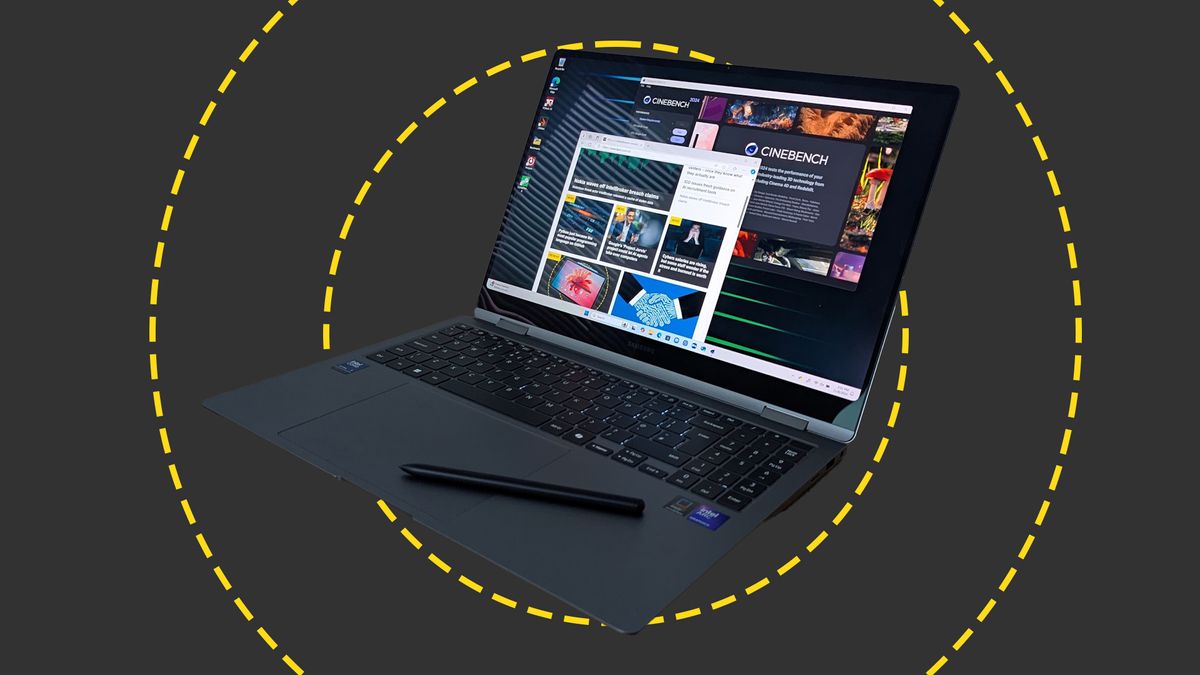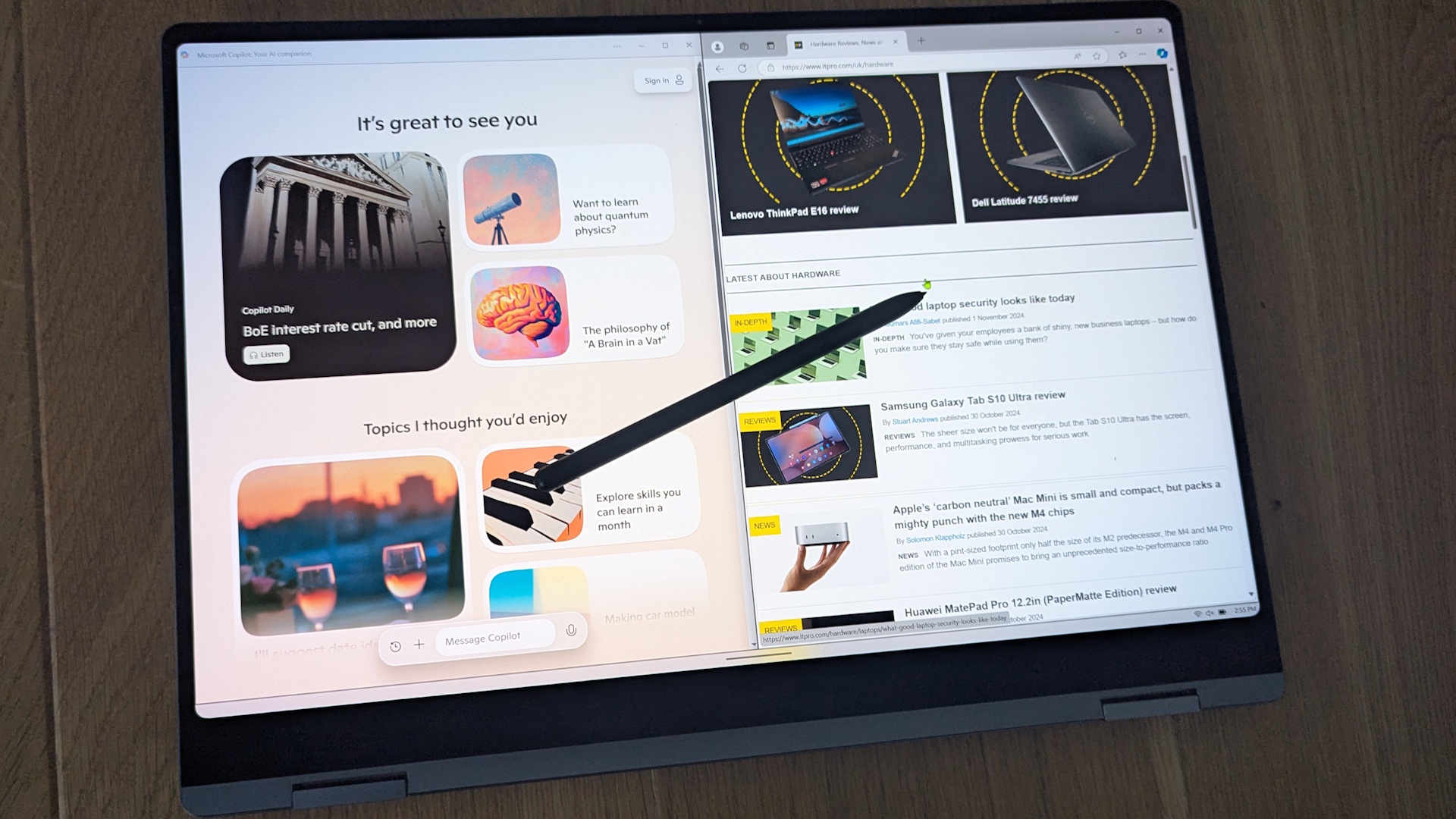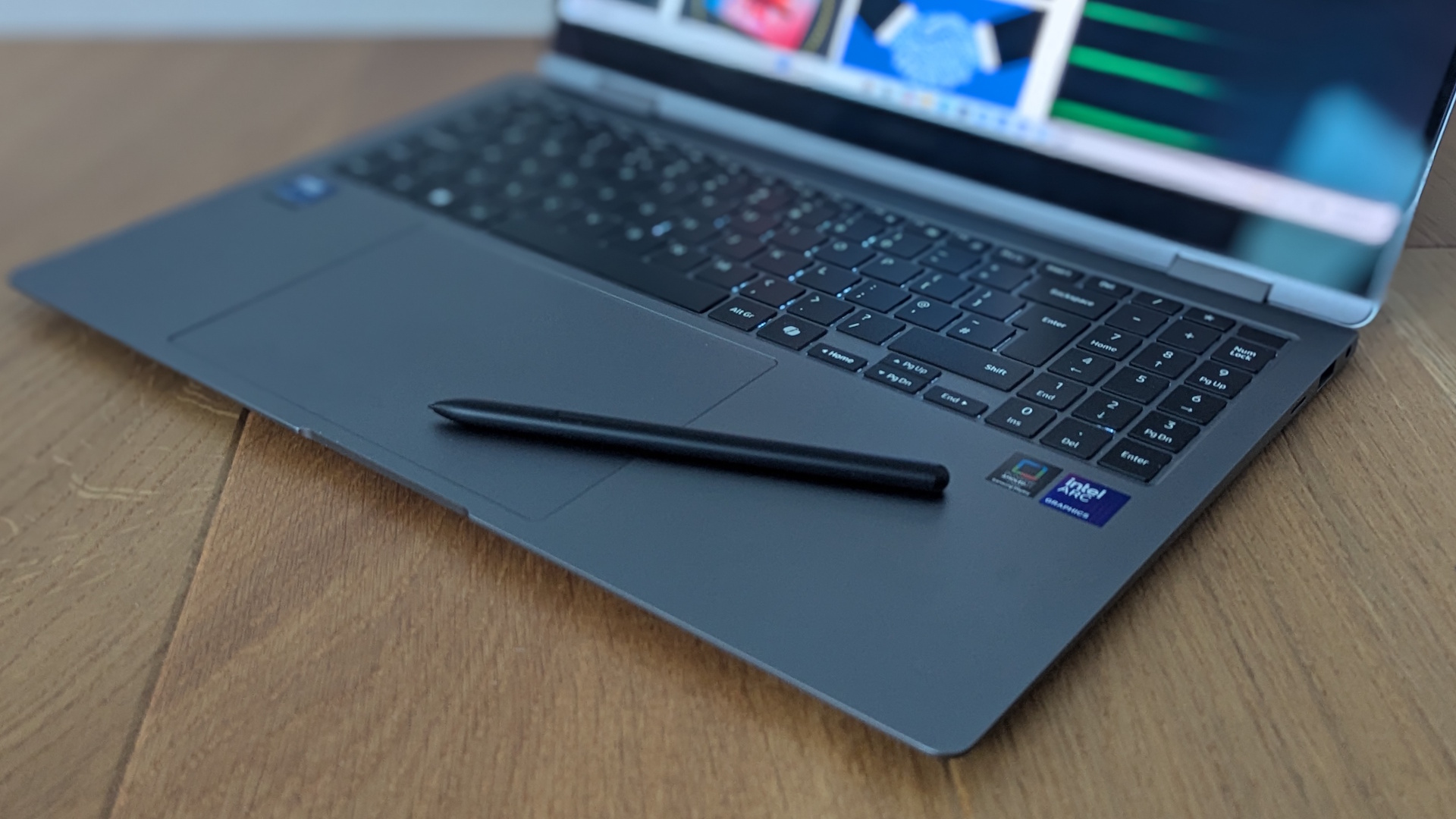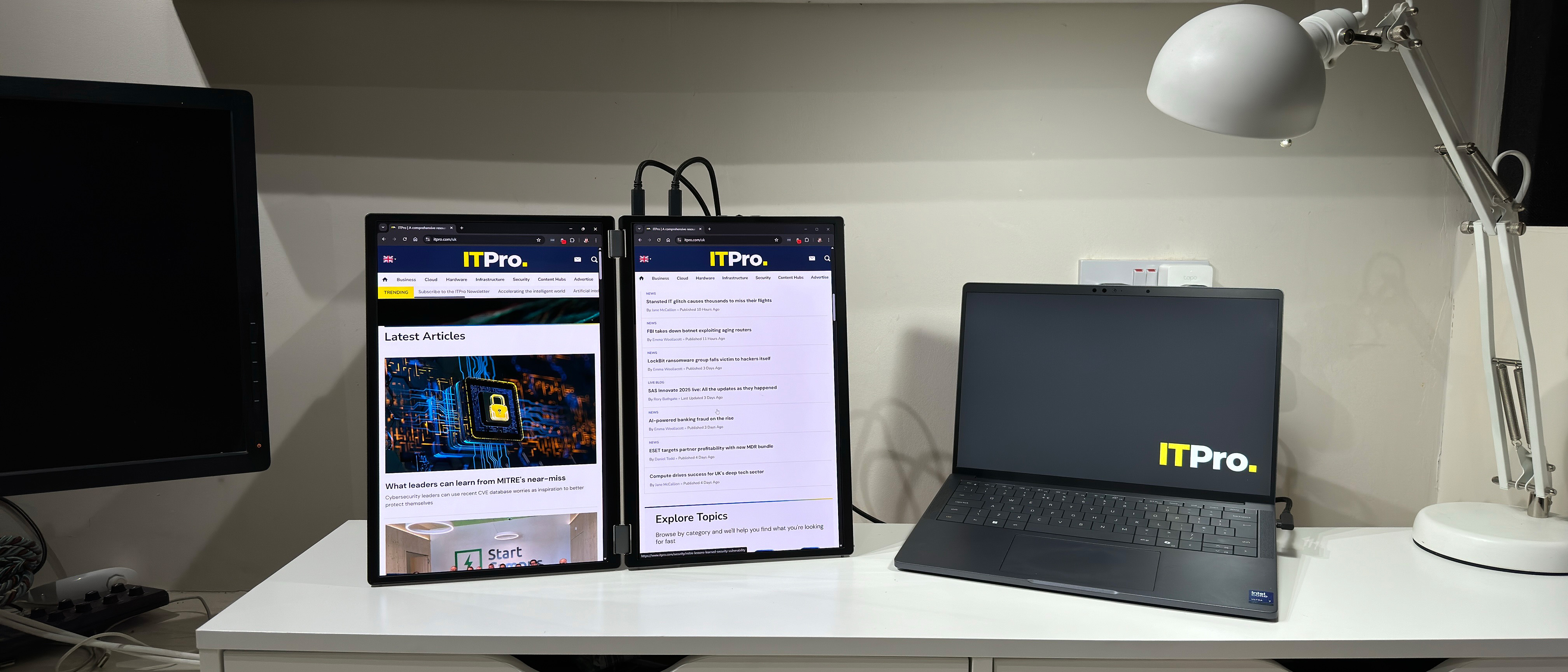Samsung Galaxy Book 5 Pro 360 review

On first impressions, the Samsung Galaxy Book 5 Pro is, almost incredible: a 16in laptop with a gorgeous display in a body less than half an inch thick. It packs in one of Intel’s new Lunar Lake processors, giving you significant built-in GPU and AI performance, along with a spacious keyboard with a dedicated numeric pad. Without wishing to spoil the rest of the review, performance is solid and battery life is off the chart. It’s one of the most elegant big-screen laptops that we’ve reviewed this year. Yet much as we think Samsung’s latest has a lot to offer business users, it’s also frustrating as it gets most of the big things right, only to fumble in one key area.
Samsung Galaxy Book 5 Pro 360: Design
Like LG with its Gram range, Samsung seems to have mastered how to make a big screen laptop without the attendant weight and bulk. The Galaxy Book 5 Pro 360 has a 355 x 252mm footprint that’s not a whole lot bigger than its 16-inch screen. It’s 12.8mm thick and 1.69Kg in weight, yet the alloy chassis feels incredibly solid, with barely noticeable seams and almost no flex in the lid. It looks fantastic with its dark grey metallic finish and works as comfortably on the lap as on the desk. Only when the hardware is pushed hard does it emanate the slightest bit of noise or heat, and even then we’re talking a little surface warmth and not much of a racket.
What’s more, the design is versatile. As the name suggests, the Book 5 Pro 360 has a 360-degree hinge, enabling you to push the back of the screen against the base and use it as an oversized tablet, or in a tent configuration as a smart screen or compact all-in-one PC. Samsung has even provided an S-Pen stylus for making notes or freehand sketching. There’s no garage to stow it away in, only a magnetic area on the lid, but it’s a useful addition for a laptop of this type.
Where many recent slim-and-light laptops have offered a tiny range of ports, The Book 5 Pro 360 goes beyond the usual two Thunderbolt 4/USB Type-C ports to fit in a full-sized HDMI 2.1 video output and a USB 3.2 Gen 2 Type-A port too. Throw in Wi-Fi 6 for the home or office network, and you’ve got everything you need for work or presentations in the body of the laptop itself.
But now we come to the Galaxy Book 5’s biggest problem: everyday usability. Its touchpad is just too damn big, measuring roughly 15 by 10.9cm and occupying a huge chunk of the laptop’s deck. It gives you a big working area to go with the big screen, and it’s as smooth and effective in its tracking as you could wish for. Yet it also leaves your left hand crammed into the bottom-left hand corner while you’re typing, which is an issue when the keyboard is also so large and the layout so spacious.
As for that keyboard, the off-balance typing position is only the start. The layout itself is mostly fine, despite the disappointingly small left Shift and Ctrl keys, but the action is very shallow, giving you not quite enough tactile feedback when you click down on a key. Initially, we also found the keys were occasionally tough to actuate, though this did improve with time and practice. Usability is always subjective, but the keyboard makes the Galaxy Book 5 Pro 360 less of a pleasure to use. It’s a laptop you slowly get accustomed to, rather than one that feels right from the word go.
Samsung Galaxy Book 5 Pro 360: Display
The AMOLED screen is an absolute knockout. With a maximum 377cdm/2 with SDR content, It doesn’t go insanely bright in normal use, but whites look pretty dazzling and it’s usable in anything bar direct sunlight. Meanwhile, the combination of the 16in screen size and the 2880 x 1800 resolution gives you both a pin-sharp picture and an enormous space to work on, perfect for the kind of task where you’re pulling in information from multiple apps and documents or doing complex creative work.
Color reproduction is almost flawless, with the AMOLED tech covering 100% of the sRGB color gamut with a volume of 150% and 98.5% of DCI-P3 with a volume of 106%. The average Delta-E creeps just above 1, at 1.19, but it’s still low enough for color-critical design work.
The front-facing camera isn’t always so impressive, delivering slightly noisy video in low light conditions with a weird color creep effect on areas of skin. Still, it’s perfectly adequate for online meetings during daylight hours. The sound, meanwhile, is clear, warm, and unexpectedly full-bodied. Neither voice calls, videos nor background music will leave you wishing that you’d plugged some headphones in.

Samsung Galaxy Book 5 Pro 360: Performance
The Galaxy Book 5 Pro 360 we had in for testing pairs an Intel Core Ultra 7 265V processor with 16GB of DDR5 RAM and a 1TB SSSTC PCIe 4.0 SSD. The CPU has four performance cores running at up to 5GHz and four low power efficient cores at up to 3.7GHz, with none of the SMT tech that, on earlier Intel chips or current AMD CPUs, allowed a single core to run two threads at once.
Intel’s new architecture is extremely efficient and most apps run at impressive speeds. In our time with the Galaxy Book 5 Pro 360, it never felt anything less than snappy and super-responsive. In the PCMark10 productivity applications benchmark its score of 6779 isn’t massively behind the Asus Zenbook S16 (7229) or the Asus ProArt PX13 (7534), both of which have AMD’s 12-core/24-thread Ryzen AI 9 HX 370 chips.
Yet in benchmarks that focus on multi-threaded performance, the Core Ultra 7 265V struggles to keep up. The Galaxy Book 5 scores 11037 in the Geekbench 6 multi-core benchmark and 618 in Cinebench 2024’s multi-threaded rendering tests. The Zenbook S16 scores 13508 and 877 in the same tests, with the ProArt PX13 at 15080 and 1023.
The Galaxy Book 5 Pro 360 is also competing with machines based on Qualcomm’s new Snapdragon X Elite chips. These won’t run the PCMark10 benchmark, but they deliver even higher figures in Geekbench 6 and Cinebench 2024. For example, the Asus Vivobook S15 scored 14337 in Geekbench 6’s multi-core tests and 941 in Cinebench R24.
To be honest, this shouldn’t worry you if you’re not a heavy user of demanding multi-threaded apps. If your focus is on office and productivity work, the Galaxy Book 5 Pro is going to be more than fast enough. What’s more, the Core Ultra 7 is a good all-rounder, with impressive 3D performance and an NPU that meets and beats the requirements of Microsoft’s Copilot+ PC spec. You won’t find any Spapdragon X laptops scoring 4302 in the 3D Mark TimeSpy test, and 47TOPS of AI processing power isn’t to be sniffed at, either. As more applications roll in AI features, the Galaxy Book 5 Pro should be well-equipped to run them.

At the time of writing, the Copilot+ features of Windows 11 still don’t install and run on Intel or AMD’s tech. What’s more, Samsung is pushing a number of Galaxy AI features with the Galaxy Book 5 Pro 360 that actually require a linked Samsung phone with Galaxy AI to run them, merely using the laptop as an external screen. It would be slightly more impressive were these features running on the laptop itself.
Still, let’s not hold Samsung’s marketing against it. Instead, let’s end with an unexpected strength. We fully expected the Book 5 Pro 360 to fall down on battery life, even with the energy efficiency of Intel’s CPU taken into account. After all, no machine with a massive OLED screen can give you much more than a working day?
Well, we were wrong. In our standard video rundown test with the screen calibrated to a brightness of 170cdm/2, the Book 5 Pro 360 kept going 21hrs and 57min, making it the longest-lasting Windows laptop that we’ve ever tested.
There is one big caveat here. Intel’s CPU can now run 1080p and 4K video on its most power-efficient cores, meaning what you get when playing video won’t necessarily be matched when running business apps. All the same, it’s incredibly impressive, and in practice, we’ve found that the Samsung can get me through one working day and most of the next morning without having to plug into the mains.
Samsung Galaxy Book 5 Pro 360: Is it worth it?
The Galaxy Book 5 Pro 360 comes close to being the best big-screen laptop we’ve seen this year. There’s nothing much to fault about the screen, the core design or the performance, and its NPU and connectivity should keep it relevant for years to come. Yet the keyboard and general usability aren’t quite at the same level, acting as a drag on the overall experience. If you can get used to the off-kilter position and shallow travel, you’ll find a serious productivity machine with epic stamina. If not, you might be left wondering how Samsung got so much right, yet missed something so crucial.
Samsung Galaxy Book 5 Pro 360 specifications
| Display | 16-inch 2,880 x 1,600 AMOLED, 60Hz refresh rate | Row 0 – Cell 2 | Row 0 – Cell 3 |
| Processor | Intel Core Ultra 7 256V, 2.2 to 48GHz | Row 1 – Cell 2 | Row 1 – Cell 3 |
| GPU | Intel Arc 140V | Row 2 – Cell 2 | Row 2 – Cell 3 |
| RAM | 16GB LPDDR5X | Row 3 – Cell 2 | Row 3 – Cell 3 |
| Ports | 2x Thunderbolt 4/USB Type-C, 1x HDM I2.1, 1x USB 3.2 Gen 2, MicroSD | Row 4 – Cell 2 | Row 4 – Cell 3 |
| Storage | 1TB PCIe4 SSD | Row 5 – Cell 2 | Row 5 – Cell 3 |
| Connectivity | Wi-Fi 7, Bluetooth v5.4 | Row 6 – Cell 2 | Row 6 – Cell 3 |
| Weight | 1.69Kg | Row 7 – Cell 2 | Row 7 – Cell 3 |
| Dimensions | 355 x 252 x 12.8mm | Row 8 – Cell 2 | Row 8 – Cell 3 |
| Battery Capacity | 76Wh | Row 9 – Cell 2 | Row 9 – Cell 3 |
| Operating System | Windows 11 Home | Row 10 – Cell 2 | Row 10 – Cell 3 |
Source link











